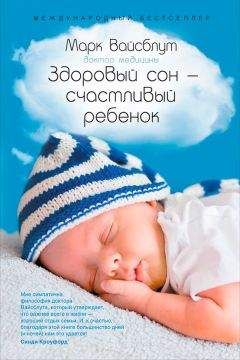Ознакомительная версия.
Многие родители начинают с постепенного подхода, видят некоторое улучшение, но затем устают и признают, что непоследовательны в своих действиях. Но, приобретая больше уверенности и знаний, многие затем начинают использовать более жесткий подход. Однако некоторые родители не могут даже приступить к исправлению нарушений сна у своих детей, так как те же самые личные трудности, которые привели к этим нарушениям (развитие у ребенка самостоятельности, семейные разногласия и прочие родительские проблемы), остаются нерешенными. Поддерживая или развивая привычку к здоровому сну у вашего ребенка, вы должны обладать достаточным мужеством для того, чтобы делать то, что будет для него лучше всего. Пройдет меньше времени, чем вы думаете, и в вашем доме воцарится атмосфера любви, в которой будут жить и счастливый, хорошо отдохнувший ребенок, и хорошо отдохнувшие родители.
Глава 1. Почему так важен здоровый сон
Bernstein, D., Emde, R., and Campos, J. (1973). REM sleep in four-month infants under home and laboratory conditions. Psychosomatic Medicine, 35, 322–329.
Coons, S., and Guilleminault, C. (1982). Development of sleepwake patterns and non – rapid eye movement sleep stages during the first six months of life in normal infants. Pediatrics, 69, 793–798.
Emde, R. N., and Metcalf, D. R. (1970). An electroencephalographic study of behavioural rapid eye movement states in the human newborn. Journal of Nervous and Mental Disorders, 150, 376–386.
Fish, B. (1963). The maturation of arousal and attention in the first months of life: A study of variations in age development. Journal of the American Academy of Child Psychiatry, 2, 253–270.
Harper, R. N., Leake, B., Miyahana, L., Mason, J., Hoppenbrouwers, T., Sterman, M. B., and Hodgman, J. (1981). Temporal sequencing in sleep and waking states during the first six months of life. Experimental Neurology, 72, 294–307.
Jacklin, C. N., Snow, M. E., Cozahapt, M., and Maccoby, E. E. (1980). Sleep pattern development from 6 through 33 months. Journal of Pediatric Psychology, 5, 295–302.
Klein, K. E., Hermann, R., Kuklinski, P., and Hans, M. W. (1977). Circadian performance rhythms: Experimental studies in air operations. In R. R. Mackie (ed.), Vigilance: Theory, Operational Performance and Physiological Correlants (NATO Conference 458 Series III, Human Factors, Vol. 3). New York: Plenum Press.
Salzarulo, P., and Chevalier, A. (1983). Sleep problems in children and their relationship with early disturbances of the wakingsleep rhythms. Sleep, 6, 47–51.
Schulz, H., Salzarulo, P., Fagioli, I., and Massetani, R. (1983). REM latency: Development in the first year of life. Electroencephalography and Clinical Neurophysiology, 56, 316–322.
Still, G. F. (1931). The History of Pediatrics. London: Oxford University Press.
Sundell, C. E. (1922). Sleeplessness in infants. Practitioner, 109, 89–92.
Глава 2. Здоровый сон и стратегии сна
Продолжительность дневного и ночного сна
Anders, T. F., Carksadon, M. A., and Dement, W. C. (1980). Sleep and sleepiness in children and adolescents. Pediatric Clinics of North America, 27, 29–43.
Anders, T. F., and Keener, M. A. (1985). Developmental course of night-time sleep-wake patterns in full-term and premature infants during the first year of life: Part I. Sleep, 8, 173–192.
Anders, T. F., Keener, M. A., and Kramer, H. (1985). Sleep-wake state organisation, neonatal assessment and development in premature infants during the first year of life: Part II. Sleep, 8, 193–206.
Cobb, K. (2002). Missed ZZZ’s, more disease: Skimping on sleep may be bad for your health. Science News, 7, 152–154.
Parmelee, A. H., Schulz, H. R., and Disbrow, M. A. (1961). Sleep patterns of the newborn. Journal of Pediatrics, 58, 241–250.
Parmelee, A. H., Wenner, W. H., and Schulz, H. R. (1964). Infant sleep patterns: From birth to 16 weeks of age. Journal of Pediatrics, 65, 576–582.
Randazzo, A. C., Muehlbach, M. L., Schweitzer, P. K., and Walsh, J. K. (1998). Cognitive function following acute sleep restriction in children ages 10–14. Sleep, 21, 861–868.
Shimada, M., Takahashi, K., Segawa, M., Higurashi, M., Samejim, M., and Horiuchi, K. (1999). Emerging and entraining patterns of the sleep-wake rhythm in preterm and term infants. Brain & Development, 21, 468–473.
Weissbluth, M. (1981). Sleep duration and infant temperament. Journal of Pediatrics, 99, 817–819.
Weissbluth, M. (1984). Sleep duration, temperament, and Conners’ ratings on three-year-old children. Journal of Developmental and Behavioral Pediatrics, 5, 120–123.
Weissbluth, M., Poncher, J., Given, G., Schwab, J., Mervis, R., and Rosenburg, M. (1981). Sleep durations and television viewing. Journal of Pediatrics, 99, 486–488.
Дневной сон
Coons, S., and Guilleminault, C. (1984). Development of consolidated sleep and wakeful period in relation to the day / night cycle in infancy. Developmental Medicine and Child Neurology, 26, 169–176.
Daiss, S. R., Bertelson, A. D., and Benjamin, L. T. (1986). Napping versus resting: Effects on performance and mood. Psychophysiology, 23, 82–88.
Emde, R. N., and Walken, S. (1961). Longitudinal study of infant sleep: Results of 14 subjects studied at monthly intervals. Psychophysiology, 13, 456–461.
Folkard, S., Hume, K. I., Minors, D. S., Waterhouse, J. M., and Watson, F. L. Independence of the circadian rhythm in alertness from the sleep-wake cycle. Nature, 313, 678–679.
Larson, M., Gunnar, M. R., and Hertsgaard, L. (1991). The effects of morning naps, car trips, and maternal separation on adrenocortical activity in human infants. Child Development, 62, 362–372.
Mahowald, M. W., and Schenck, C. H. (1992). Dissociated states of wakefulness and sleep. Neurology, 42 (Suppl. 6), 44–52.
Marks, G. A., Shaffery, J. P., Oksenberg, A., Speciale, S. G., and Roffwarg, H. P. (1995). A functional role for REM sleep in brain maturation. Behavioral Brain Research, 69, 1–11.
Minors, D. S., and Waterhouse, J. M. (1984). The sleep-wakefulness rhythm, exogenous and endogenous factors (in man). Experientia, 40, 410–416.
Sandyk, R. (1992). Melatonin and maturation of REM sleep. International Journal of Neuroscience, 63, 105–114.
Watamura, S., Sebanc, A., and Gunnar, M. (2002). Rising cortisol at child care: Relations with nap. Developmental Psychobiology, 40, 33–42.
Weissbluth, M. (1995). Naps in children: 6 months – 7 years. Sleep, 18, 82–87.
Wladimorva, G. (1993). Study of cyclic structure of daytime sleep in normal infants aged 2 to 12 months. Acta physiologica et pharmacoligica Bulgarica, 9, 62–69.
Консолидированный сон
Bonnet, M. M. (1985). Effect of sleep disruption on sleep, performance, and mood. Sleep, 8, 11–19.
Coons, S., and Guilleminault, C. (1985). Motility and arousal in near-miss sudden infant death syndrome. Journal of Pediatrics, 107, 728–732.
Martin, S. E., Engleman, H. M., Deary, I. J., and Douglas, N. J. (1996). The effect of sleep fragmentation on daytime function. American Journal of Respiratory and Critical Care Medicine, 153, 1328–1332.
Stepanski, E., Lamphere, J., Badia, P., Zorick, F., and Roth, T. (1984). Sleep fragmentation and daytime sleepiness. Sleep, 7, 18–26.
Weissbluth, M., Davis, A. T., and Poncher, J. (1984). Night waking in 4– to 8-month-old infants. Journal of Pediatrics, 104, 477–480.
Сон по графику и время засыпания
Abe, K., Sasaki, H., Takebayashi, K., Seki, F., and Roth, T. (1978). The development of circadian rhythms of human body temperature. Journal of Interdisciplinary Cycle Research, 9, 210–216.
Czeisler, C. A., Weitzman, E. D., and Moore-Ede, M. C. (1980). Human sleep: Its duration and organisation depend on its circadian phase. Science, 210, 1264–1267.
Dinges, D. F., Pack, F., Williams, K., Gillen, K. A., Powell, J. W., Ott, G. E., Aptowicz, D., and Pack, A. I. (1997). Cumulative sleepiness, mood disturbance, and psychomotor vigilance performance decrements during a week of sleep restricted to 4–5 hours per night. Sleep, 20, 267–277.
Dreyfus-Brisac, C., and Monod, N. (1965). Sleep of premature and full term neonates – A polygraphic study. Proceedings of the Royal Society of Medicine, 58, 6–7.
Emde, R. N, Swedberg, J., and Suzuki, B. (1975). Human wakefulness and biological rhythms after birth. Archives of General Psychiatry, 32, 780–783.
Lodemore, M., Petersen, S. A., and Wailoo, M. P. (1991). Development of night temperature rhythms over the first six months of life. Archives of Disease in Childhood, 66, 521–524.
Louis, J., Cannard, C., Bastuji, H., and Challamel, M.-J. (1997). Sleep ontogenesis revisited: A longitudinal 24-hour home polygraphic study on 15 normal infants during the first two years of life. Sleep, 20, 323–333.
Onishi, S., Miyazawa, G., Nishimura, Y., Sugiyama, S., Yamakawa, T., Inagaki, H., Katoh, T., Itoh, S., and Isobe, K. (1983). Postnatal development of circadian rhythm in serum cortisol levels in children. Pediatrics, 72, 399–404.
Reppert, S. M. (1985). Maternal entrainment of the developing circadian system. Annals of the New York Academy of Science, 453, 162–169.
Sadeh, A. (1997). Sleep and melatonin in infants. Sleep, 20, 185–191.
Weissbluth, M. (1982). Modification of sleep schedule with reduction of night waking: A case report. Sleep, 5, 262–266.
Регулярность сна
Acebo, C., and Carskadon, M. A. (2002). Influence of irregular sleep patterns on waking behaviour. In M. A. Carskadon (ed.), Adolescent Sleep Patterns: Biological, Social, and Psychological Influences, 220–235. Cambridge: Cambridge University Press.
Bates, J. E., Viken, R. J., Alexander, D. B., Beyers, J., and Stockton, S. (2002). Sleep and adjustment in preschool children: Sleep diary reports by mothers relate to behaviour reports by teachers. Child Development, 73, 62–74.
Положения для сна, СВДС
Ponsouby, A. L., Dwyer, M. B., Gibbons, L. E., Cochran, J. A., and Wang, Y. G. (1993). Factors potentiating the risk of sudden infant death syndrome associated with the prone position. New England Journal of Medicine, 329, 377–382.
Грудное вскармливаниепротив искусственного и родительская кровать против детской кроватки
Elias, M. F., Nicolson, N. A., Bora, C., and Johnston, J. (1986). Sleep/wake patterns of breast-fed infants in the first 2 years of life. Pediatrics, 77, 322–329.
Hayes, M. J., Parker, K. G., Sallinen, B., and Davare, A. A. (2001). Bedsharing, temperament, and sleep disturbance in early childhood. Sleep, 24, 657–662.
Hunsley M., and Thoman, E. B. (2002) The sleep of co-sleeping infants when they are not co-sleeping: Evidence that cosleeping is stressful. Developmental Psychobiology, 40, 14–22.
Klackenberg, G. (1982). Sleep behaviour studied longitudinally. Acta Paediatrica Scandinavia, 71, 501–506.
Latz, S., Wolf, A. W., and Lozoff, B. (1999). Cosleeping in context. Sleep practices and problems in young children in Japan and the United States. Archives of Pediatrics & Adolescent Medicine, 153, 339–346.
Lozoff, B., Wolf, A. W., and Davis, N. S. (1984). Co-sleeping in urban families with young children in the United States. Pediatrics, 74, 171–182.
Lozoff, B. L., Wolf. A. W., and Davis, N. S. (1985). Sleep problems seen in pediatric practice. Pediatrics, 75, 477–483.
Okami, P., Weisner, T., and Olmstead, R. (2002). Outcome correlates of parent-child bedsharing: An eighteen-year longitudinal study. Journal of Developmental & Behavioral Pediatrics, 23, 244–253.
Rosenfeld, A. A., Wenegrant, A. O., Haavik, D. K., Wenegrant, B. C., and Smith, C. R. (1982). Sleeping patterns in uppermiddle-class families when the child awakens ill or frightened. Archive of General Psychiatry, 39, 943–947.
Твердая пища и режим питания
Beal, V. A. (1964). Termination of night feeding in infancy. Journal of Pediatrics, 75, 690–692.
Deisher, R. W., and Goers, S. S. (1954). A study of early and later introduction of solids into the infant diet. Journal of Pediatrics, 45, 191–199.
Grunwaldt, E., Bates, T., and Guthrie, D. (1960). The onset of sleeping through the night in infancy: Relation to introduction of solid food in the diet, birth weight and position in the family. Pediatrics, 26, 667–668.
Jones, N. B., Brown, M. F., and MacDonald, L. (1978). The association between perinatal factors and later night waking. Developmental Medicine and Child Neurology, 20, 427–434.
Lavie, P., Kripke, D. F., Hiatt, J. F., and Harrison, J. (1978). Gastric rhythms during sleep. Behavioral Biology, 23, 526–630.
Ознакомительная версия.





